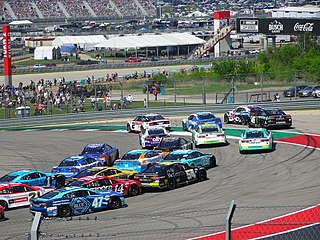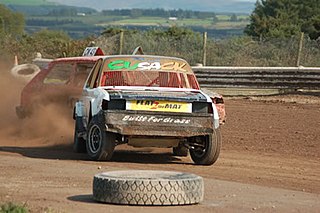
Auto racing is a motorsport involving the racing of automobiles for competition. In North America, the term is commonly used to describe all forms of automobile sport including non-racing disciplines.

Drag racing is a type of motor racing in which automobiles or motorcycles compete, usually two at a time, to be first to cross a set finish line. The race follows a short, straight course from a standing start over a measured distance, most commonly 1⁄4 mi, with a shorter, 1,000 ft distance becoming increasingly popular, as it has become the standard for Top Fuel dragsters and Funny Cars, where some major bracket races and other sanctioning bodies have adopted it as the standard. The 1⁄8 mi is also popular in some circles. Electronic timing and speed sensing systems have been used to record race results since the 1960s.

Sports car racing is a form of motorsport road racing which utilises sports cars that have two seats and enclosed wheels. They may be either purpose-built sports prototypes which are the highest level in sports car racing or grand tourers based on road-going models and therefore, in general, not as fast as sports prototypes. Sports car racing is one of the main types of circuit auto racing, alongside open-wheel racing, touring car racing and stock car racing. Sports car races are often, though not always, endurance races that are run over particularly long distances or large amounts of time, resulting in a larger emphasis on the reliability and efficiency of the car and its drivers as opposed to outright car performance or driver skills. The FIA World Endurance Championship is an example of one of the best known sports car racing series.

Sprint cars are open-wheel race cars, designed primarily for the purpose of running on short oval or circular dirt or paved tracks. Historically known simply as "big cars," distinguishing them from "midget cars," sprint car racing is popular primarily in the United States and Canada, as well as in Australia, New Zealand, and South Africa.
Dirt track racing is a form of motorsport held on clay or dirt surfaced banked oval race tracks. Dirt track racing started in the United States before World War I and became widespread during the 1920s and 1930s using both automobiles and motorcycles, spreading throughout Japan and often running on horse racing tracks. There are a myriad of types of race cars used, from open wheel Sprint cars and Modifieds to stock cars. While open wheel race cars are purpose-built racing vehicles, stock cars can be either purpose-built race cars or street vehicles that have been modified to varying degrees. There are hundreds of local and regional racetracks throughout the United States and also throughout Japan. The sport is also popular in Canada, Mexico, Argentina, Brazil, Chile, Australia, New Zealand, South Africa and the United Kingdom.

Autograss is a form of motor racing, with races organised at various venues across the UK and Ireland. The roots of the discipline can be traced back to the 1960s.

Radical Motorsport is a British manufacturer and constructor of racing cars. The company was founded in January 1997 by amateur drivers and engineers Mick Hyde and Phil Abbott, who built open cockpit sportscars which could be registered for road use and run on a track without modification. Radical produce a mix of purpose built race cars as well as road legal sports cars in varying specifications. Their most popular car is the Radical SR3.

Pro Modified, also known as Pro Mod, is a class or division in the sport of drag racing used in the NHRA and FIA (quarter-mile) and the Professional Drag Racers Association (PDRA) (eighth-mile). It is similar to the Top Doorslammer class as defined by the ANDRA.

Australian Formula 2, sometimes abbreviated to AF2 or ANF2, is a "wings and slicks" formula racing category in Australia. The category is one of Australia's oldest, dating back to 1964. The current format of AF2 was introduced in 1978. Brian Shead of Cheetah Racing Cars and Garrie Cooper of Elfin Sports Cars were largely responsible for the development of the format, which was devised to suit the needs of Australian drivers, most of whom had little or no sponsorship and had to bear the costs of racing out of their own pockets.

The motorcycle sport of racing includes motorcycle road racing and off-road racing, both either on circuits or open courses, and track racing. Other categories include hill climbs, drag racing and land speed record trials.

The Clubman is a class of prototype front-engined sports racing cars that originated in Britain in 1965 as a low-cost formula for open-top, front-engined roadgoing sports cars like the Lotus 7, which had been crowded out of the mainstream by rear-engined cars such as the Lotus 23.

The Holden HQ series is a range of automobiles that was produced by Holden in Australia from 1971 to 1974. The HQ was released on 15 July 1971, replacing the Holden HG series. It was the first ground-up redesign of the Holden line since its original release in 1948, and included an all-new body, chassis, and suspension. The HQ was later developed into a series of successor models, finally ending production when the WB series was discontinued in 1985.
Superbike World Championship is a silhouette road racing series based on heavily modified production sports motorcycles.

The Supersport World Championship, abbreviated to WorldSSP, is a motorcycle racing competition on hard-surfaced circuits, based on mid-sized sports motorcycles. Competition machines were originally based on production-based motorcycles with 600 cc to 955 cc engines, depending on the number of cylinders. After trials in UK national series British Supersport, from 2022 the regulations have changed to allow eligibility of larger-displacement engines, to reflect the engine sizes being produced and encourage different manufacturers.
Embassy Racing was a British auto racing team founded by Jonathan France in 2003. Initially created as a conjunction with Xero Competition in the British GT Championship, the team expanded to become an independent team and began to win races in British GT before the team took a sabbatical year in 2006. Upon their return to motorsport, Embassy moved to the international Le Mans Series, running in a Le Mans Prototype class, as well as entering the British Superbike Championship's junior leagues, the Supersport and Superstock Championships, running with the support of Triumph Motorcycles under the MAP Embassy Triumph banner.

Superbike racing is a category of motorcycle racing that employs highly modified production motorcycles, as opposed to MotoGP in which purpose-built motorcycles are used. The Superbike World Championship is the official world championship series, though national Superbike championships are held in many countries, including the United Kingdom, the United States, Japan, Australia and Canada. Superbike racing is generally popular with manufacturers, since it helps promote and sell their product, as captured by the slogan "Win on Sunday; Sell on Monday".
Minetti Sports Cars is an Australian company which designs and constructs racing cars. It was established in 2003 and located on the Sunshine Coast, Queensland. Minetti started with the ZZ/I design, utilised for small engine capacity prototype sports car racing. Since then Minetti have followed up with the SS-V1 design. Both cars have utilised motorcycle sourced engines, mostly Suzuki Hayabusa, for powerplants to run in the Supersports category. The earlier ZZ/I design has won championships at state level in both New South Wales and Queensland while the later SS-V1 has had class wins in the QLD Sportscar Championship and also took out the 2008 National Supersprint Championship.
The Australian Prototype Series is an Australian motor racing series for competitors smaller-engined prototype sports cars. Originally known as Sports Racer Series, eligibility is something of a polyglot collection of existing racing cars and racing categories, featuring Group 2C Supersport racing cars, which in itself is an amalgamation of the former Clubman Sports 1300 regulations with some newer motorcycle engined cars built specifically for Supersports, and a group of Category 6 sports cars produced by West, Minetti, Radical, Lincspeed and ADR, many of which formerly raced as Prototype Sports Cars, or Protosports. Drawing from so many different sources, entry was diverse. The first race meeting for the new category was held at the 2010 Clipsal 500 V8 Supercar race meeting. By 2011 the majority of the grid were American style SCCA DSR class Wests.

The following outline is provided as an overview of motorcycles and motorcycling:
The Australian Clubman, later known as Sports 1300 class catered for small capacity front engine rear wheel drive sportscars initially similar to the road going sports cars such as the Lotus 7 and to other Clubman series internationally. These cars were simple two seat cars based on widely available road car components in a purpose-built space frame chassis and simple bodywork using cycle guards over the front wheels. The basic features of these cars were













